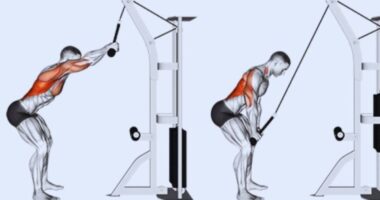The rear delt row is a compound exercise that targets the rear deltoid muscle, also known as the posterior deltoid. This exercise is an effective way to strengthen the upper back and shoulders while improving posture and reducing the risk of injury. In this article, we will discuss how to properly perform the rear delt row exercise, the muscles worked, the benefits, and some alternative exercises that you can include in your workout routine.
What is Rear Delt Row?
The Rear Delt Row is an exercise that primarily targets the rear deltoid muscle, which is the muscle located on the back of the shoulder. The exercise is typically performed using dumbbells but can also be done with a barbell or cable machine.
There are a variety of names for the rear delt row exercise, including the standing rear delt row, barbell rear delt row, and bent-over rear delt row, however, they all refer to the same movement of bending over at the waist while holding a barbell or dumbbell, lying down with your arms hanging straight down toward the ground, and then pulling the barbell or dumbbell straight up toward your chest until your elbows are squeezed in half.
Rear Delt Row Muscles Worked
The Rear Delt Row primarily targets the rear deltoid muscle, which is the muscle located on the back of the shoulder. However, this exercise also works other muscles in the upper back and shoulders, including the middle trapezius and rhomboid muscles. The middle trapezius is a large, diamond-shaped muscle that is located in the middle of the back, while the rhomboid muscles are located between the spine and the shoulder blades. Strengthening these muscles helps to improve posture, reduce the risk of shoulder and neck injuries, and increase upper body strength.
Benefits of Barbell Rear Delt Row
Strengthening the muscles targeted by the Barbell Rear Delt Row exercise provides several benefits, including:
Improved Posture
Strengthening the upper back and shoulders through this exercise can help improve posture by reducing the risk of slouching or hunching forward. When these muscles are strong, they can help to pull the shoulders back and down, which can help to counteract the effects of sitting at a desk or using a computer for extended periods.
Reduced Risk of Injury
Strengthening the rear deltoid, middle trapezius, and rhomboid muscles can help reduce the risk of shoulder and neck injuries by improving the stability and strength of these areas. When these muscles are weak, it can lead to poor posture and an increased risk of strain or injury.
Increased Upper Body Strength
The Rear Delt Row is a compound exercise that targets multiple muscles in the upper back and shoulders, making it an effective way to increase overall upper body strength. This can improve your ability to perform daily activities that require upper body strength, such as lifting and carrying heavy objects.
Improved Athletic Performance
Strong upper back and shoulder muscles are important for athletes who participate in sports that require upper body strength, such as swimming, rowing, and gymnastics. Strengthening these muscles through exercises like the Rear Delt Row can help to improve performance and reduce the risk of injury.
Versatile Exercise
The exercise can be performed with various equipment, including dumbbells, resistance bands, and cable machines, making it a versatile exercise that can be easily incorporated into any workout routine. If you do this, you will be able to keep your workouts interesting and challenging, which can help you stay motivated and prevent boredom from setting in.
Read Also: How to do dumbbell shoulder fly
How to Perform Dumbbell Rear Delt Row Correctly?
Performing the Rear Delt Row exercise correctly is important to ensure that you target the intended muscles and reduce the risk of injury. Here are the steps to perform the exercise correctly:
- Stand with your feet shoulder-width apart and hold a dumbbell in each hand, palms facing toward your body.
- Bend forward at the hips until your torso is nearly parallel to the ground. Keep your back straight and your core engaged in maintaining proper form.
- Bring your shoulder blades together and down towards your spine, and keep your elbows close to your body.
- Pull the dumbbells towards your chest, keeping your elbows close to your body and squeezing your shoulder blades together. Hold this position for a few seconds.
- Slowly lower the dumbbells back down to the starting position, keeping your back straight and your core engaged.
- It is recommended to repeat this movement for as many repetitions as you like.
By following the instructions you can exactly perform this exercise with a barbell, you just need to replace the dumbbells with the barbell.
Common Mistakes to Avoid while performing Rear Delt Row
Performing the Rear Delt Row exercise correctly is important to ensure that you target the intended muscles and reduce the risk of injury. Here are some common mistakes to avoid while performing the exercise:
Using Too Much Weight
Using too much weight can cause you to use momentum or swing your body to lift the weights, which can increase the risk of injury and reduce the effectiveness of the exercise. It’s important to choose an appropriate weight that allows you to perform the exercise in the proper form.
Hunching Your Shoulders
When you hunch your shoulders during the exercise, you are less likely to be able to perform the exercise effectively and you are more likely to suffer an injury. Instead, keep your shoulders down and back throughout the movement.
Flaring Your Elbows
You should avoid pointing your elbows out to the sides while you are exercising because this causes unnecessary stress on your shoulders and can reduce the effectiveness of your workout. Keep your elbows close to your body throughout the movement.
Arching Your Back
For the exercise to be effective, you must avoid arching your back since it causes unnecessary stress on your lower back. Instead, keep your back straight and your core engaged throughout the movement.
Rushing Through the Exercise
If you rush through the exercise, it can reduce its effectiveness and increase an individual’s chances of getting injured as well. Instead, perform the exercise slowly and with proper form, focusing on squeezing your shoulder blades together at the top of the movement.
By avoiding these common mistakes and focusing on proper form, you can ensure that you target the intended muscles and reduce the risk of injury while performing the Rear Delt Row exercise.
Rear Delt Row Alternatives and Variations
While the Rear Delt Row is an effective exercise for targeting the rear deltoid muscle and improving upper body strength, several alternatives can be used to add variety to your workout routine. Here are some alternatives:
Barbell Rear Delt Row
Bent-over reverse flyes are an exercise that targets the rear deltoids and upper back muscles. To perform the exercise, bend forward at the hips with a dumbbell in each hand, palms facing towards each other, and lift the dumbbells out to the sides, squeezing your shoulder blades together.
Chest-Supported Rear Delt Row
The Chest-Supported Rear Delt Row can be performed using a bench and dumbbells. To perform the exercise, lie face down on an incline bench with your chest supported and your feet on the ground. Hold a dumbbell in each hand with your palms facing inwards, and lift the dumbbells towards your chest, squeezing your shoulder blades together at the top of the movement.
Cable Rear Delt Row
The Cable Rear Delt Row is another variation of the Rear Delt Row that can be performed using a cable machine. To perform the exercise, attach a rope to a cable machine and hold the rope with both hands, palms facing inwards. With your arms extended in front of you, pull the rope towards your chest, keeping your elbows high and your shoulder blades squeezed together at the top of the movement.
Related Posts
Cable Rope Pullover, How to, Muscles Worked, Alternatives
Pinch Press: How To, Muscles Worked, Benefits, Alternatives
Humble Row, How to, Muscles Worked, Benefits, Alternatives









